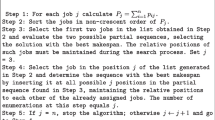“…What Is Good and What Is Bad?…” V. Mayakovsky
Abstract
This paper presents a method for the impartial assessment of the quality of scientific and technological natural language documents and their collections by using bibliometric and scientometric indicators. The method of computational document search and design of document collections that are adequate for calculating reference values to assess the quality of the documents and document collections is formulated. This method is based on the mathematical modeling of natural language texts. Examples of the obtained assessments are presented.
Similar content being viewed by others
References
I. V. Marshakova-Shaikevich, “The role of bibliometrics in the evaluation of research activity of the science,” Upravl. Bol’sh. Sist. 44, 210–247 (2013).
L. Bornmann, A. Thor, W. Marx, and H. Schier, “The application of bibliometrics to research evaluation in the humanities and social sciences: an exploratory study using normalized google scholar data for the publications of a research institute,” J. Assoc. Inform. Sci. Technol. (in press).
L. Bornmann and R. Haunschild, “The interest of the scientific community in expert opinions from journal peer review procedures,” Scientometrics 102, 2187–2188 (2015).
J. Ruiz-Castillo and L. Waltman, “Field-normalized citation impact indicators using algorithmically constructed classification systems of science,” J. Informetrics 9, 102–117 (2015).
N. J. van Eck and L. Waltman, “CitNetExplorer: a new software tool for analyzing and visualizing citation networks,” J. Informetrics 8, 802–823 (2014); arXiv:1404/5322.
L. Waltman and R. Costas, “F1000 recommendations as a new data source for research evaluation: a comparison with citations,” J. Assoc. Inform. Sci. Technol. 65, 433–445 (2014); arXiv:1303.3875.
L. Waltman and N. J. van Eck, “A systematic empirical comparison of different approaches for normalizing citation impact indicators,” J. Informetrics 7, 833–849 (2013); arXiv:1301.4941.
L. Waltman and N. J. van Eck, “Source normalized indicators of citation impact: an overview of different approaches and an empirical comparison,” Scientometrics 96, 699–716 (2013); arXiv:1208.6122.
L. Waltman and M. Schreiber, “On the calculation of percentile-based bibliometric indicators,” J. Am. Soc. Inform. Sci. Technol. 64, 372–379 (2013).
L. Waltman, N. J. van Eck, and P. Wouters, “Counting publications and citations: is more always better?,” J. Informetrics 7, 635–641 (2013); arXiv:1301.4597.
L. Bornmann and L. Leydesdorff, “Does quality and content matter for citedness? A comparison with para-textual factors and over time,” J. Informetrics 9, 419–429 (2015).
L. Bornmann, “Redundancies in h index variants and the proposal of the number of top-cited papers as an attractive indicator,” Measurement 10, 149–153 (2012).
L. Waltman, A. F. J. van Raan, N. J. van Eck, and W. C. Peul, “Citation analysis may severely underestimate the impact of clinical research as compared to basic research,” PLoS ONE 8, e62395 (2013); arXiv:1210/0442.
B. Z. Iliev, “Measuring the evaluation and impact of scientific works and their authors,” (2013); arXiv:1311/6948.
S. V. Bredikhin and A. Yu. Kuznetsov, Bibliometric Methods and the Electronic Scientific Periodicals Market (IVMiMG SO RAN, NEIKON, Novosibirsk, 2012) [in Russian].
O. P. Morozova, “Hirsch index as a scientometric indicator: comparative analysis and its modifications,” Nauch.-Tekh. Inform., Ser. 1: Organiz. Metodika Inform. Raboty, No. 2, 30–33 (2011).
V. V. Nalimov and Z. M. Mul’chenko, Scientometry (Nauka, Moscow, 1969) [in Russian].
N. S. Red’kina, “Bibliometrics: history and the present,” Molodye Bibliotech. Dele 2, 76–86 (2003).
O. V. Fedorets, “Using the weighted impact factor to create a list of the most-cited multidisciplinary journals,” Nauch.-Tekh. Inform., Ser. 1: Organiz. Metodika Inform. Raboty, No. 7, 22–27 (2011).
O. Kücüktunç, E. Saule, K. Kaya, and Ü. V. Catalyürek, “Diversifying citation recommendations,” ACM Trans. Intell. Syst. Technol. 5 (4), 55 (2015); arXiv:1209/5809.
J. K. Vanclay, “Impact factor: outdated artefact or stepping-stone to journal certification?,” Scientometrics 92, 211–238 (2012); arXiv:1201.3076.
J. K. Vanclay and L. Bornmann, “Metrics to evaluate research performance in academic institutions: a critique of ERA 2010 as applied in forestry and the indirect H2 index as a possible alternative,” Scientometrics 91, 751–771 (2012).
Numbers Game, or as We Now Appreciate the Work of the Scientist, Collection of Articles in Bibliometrics (MTsNMO, Moscow, 2011) [in Russian].
T. Saracevic, “Effects of inconsistent relevance judgments on information retrieval test results: a historical perspective,” LIBRARY TRENDS.he Legacy of F. W. Lancaster 56, 763–783 (2008).
M. G. Kreines, “Models and technologies for the extraction of aggregated Knowledge to control processes of the retrieval of non-structured information,” J. Comput. Syst. Sci. Int. 48, 272 (2009).
M. G. Kreines, “Methods of computational analysis of semantic models for quality assessment of scientific texts,” J. Comput. Syst. Sci. Int. 52, 226 (2013).
A. N. Petrov, M. G. Kreines, and A. A. Afonin, “Semantic search of the unstuctured natural language texts in the management of the research and development programs’ expertise,” Informatiz. Obrazov. Nauki 18 (2), 54–67 (2013).
M. G. Kreines and A. A. Afonin, “Clusterization of text collections: help with a content search and analytical tool,” in Internet-portals: Content and Technologies (Prosveshchenie, Moscow, 2007), No. 4, pp. 510–537 [in Russian].
Author information
Authors and Affiliations
Corresponding author
Additional information
Original Russian Text © M.G. Kreines, E.M. Kreines, 2016, published in Izvestiya Akademii Nauk, Teoriya i Sistemy Upravleniya, 2016, No. 5, pp. 73–89.
Rights and permissions
About this article
Cite this article
Kreines, M.G., Kreines, E.M. The control model for the selection of reference collections providing the impartial assessment of the quality of scientific and technological publications by using bibliometric and scientometric indicators. J. Comput. Syst. Sci. Int. 55, 750–766 (2016). https://doi.org/10.1134/S1064230716040092
Received:
Accepted:
Published:
Issue Date:
DOI: https://doi.org/10.1134/S1064230716040092




